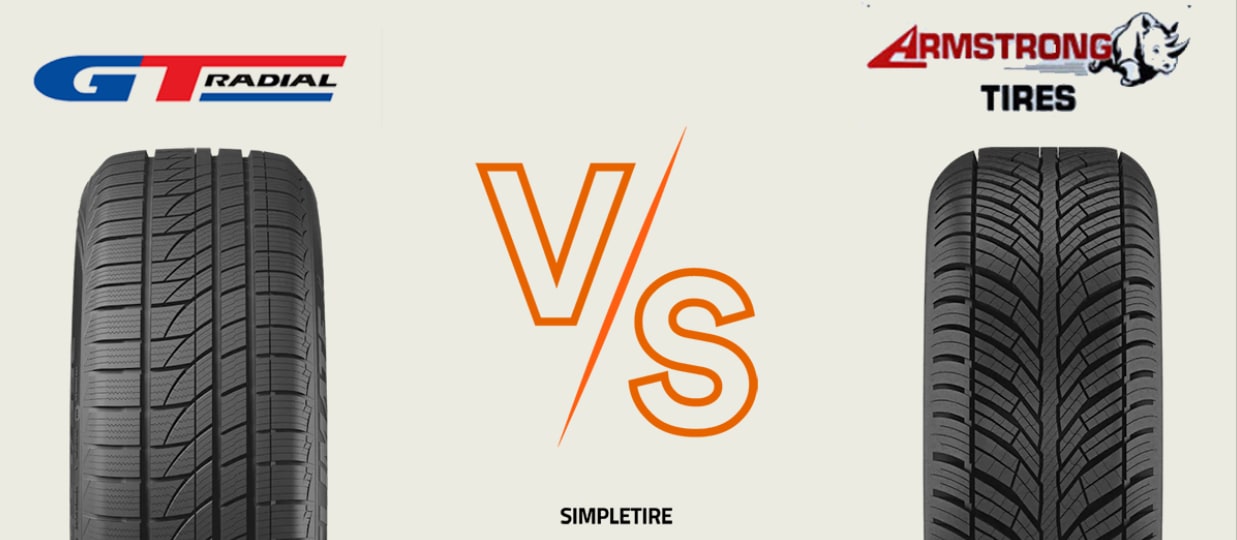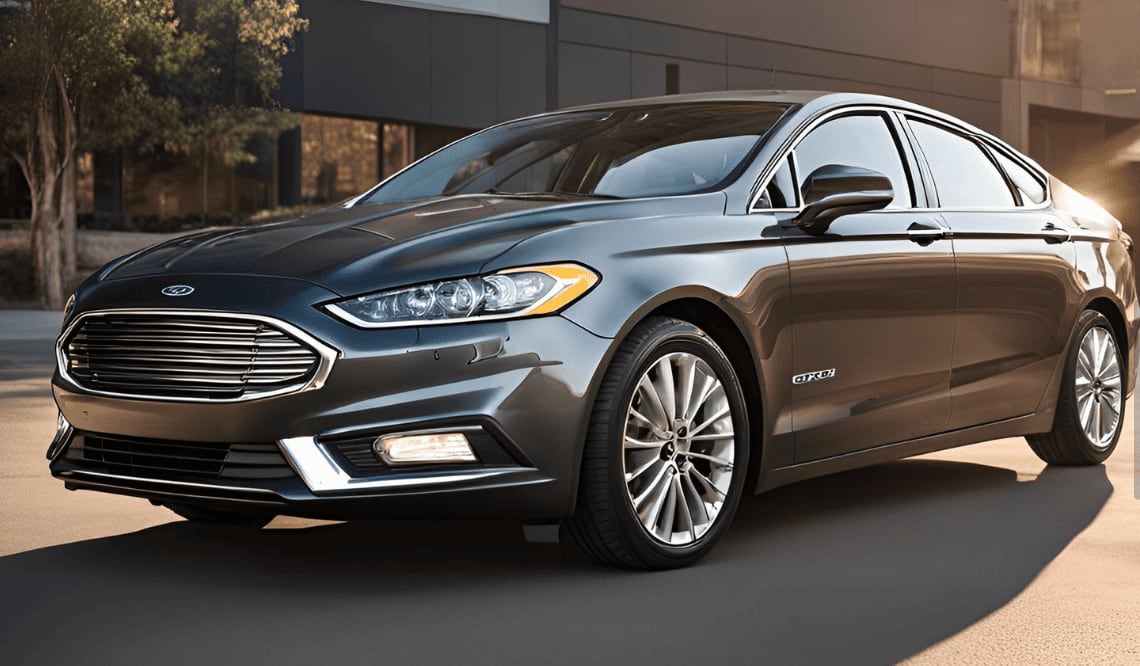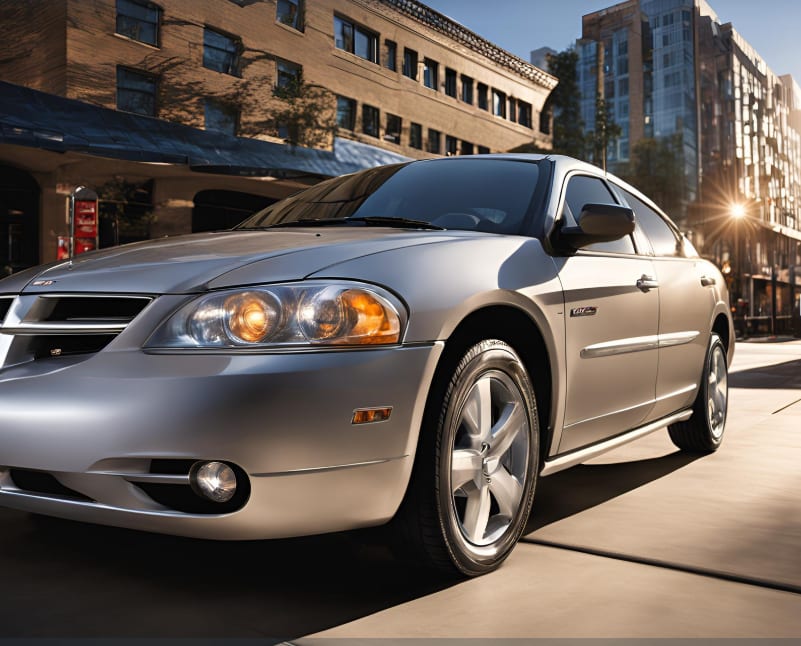Compare

GT Radial, based in Singapore, is a member of Giti Tire and has been in the North American tire industry for over 25 years. Its objective is to help drivers get the most out of every road, ride, day, and dollar. Founded in 1912, Armstrong, and by the 1960s, Armstrong tires are well-known for their adaptable and inventive passenger and SUV tires, available in a variety of categories.
GT Radial's tire family includes the Champiro and Maxtour for passenger cars, Adventuro for light trucks and SUVs, IcePro for winter conditions, and Maxmiler for freight vans and trailers. All-weather tire, the GT Radial MaxClimate is designed for coupes, sedans, CUVs, and minivans and offers drivers year-round performance plus a 60,000 mile limited manufacturer tread life warranty.
Armstrong Tires is well-known for its innovative and versatile passenger and SUV tires, including the Tru-Trac and Blu-Trac tire families, as well as the Ski-Trac winter tires. Designed for use on passenger cars, the Armstrong Blu-Trac PC Flex is an all-weather tire that offers drivers consistent wet and dry traction, confident braking, and grip, and a 50,000 mile limited manufacturer tread life warranty.
Let’s compare the GT Radial MaxClimate and the Armstrong Blu-Trac PC Flex using SimpleScore to help you determine which tire is best for you.
GT Radial MaxClimate tires

An all-weather tire, the GT Radial MaxClimate is designed for sedan drivers who seek optimum comfort, grip in dry and wet situations, and light snow traction. It also performs better in ice and snow than a regular all-season tire. This all-weather tire is covered by a 60,000 mile limited manufacturer tread life warranty. Three Peak Mountain Snowflake certified, the MaxClimate meets the Tire & Rubber Association of Canada's (TRAC) traction requirements on snow-covered roads. Additionally, its innovative architecture ensures a smooth, quiet ride with precise handling, making it ideal for everyday commuting and longer road trips.
On average, the GT Radial MaxClimate sports a great SimpleScore of 8.2 out of 10 thanks to its excellent longevity, sharp handling, and consistent traction.
Armstrong Blu-Trac PC Flex tires

For performance versatility across the seasons, this new generation of all-weather tires, the Armstrong Blu-Trac PC Flex functions as a cross between a summer and winter tire. While the unique blend of compounds provides grip in different circumstances and enhances fuel efficiency, the combination of summer and winter sipes offers great traction in the snow. Backed by a 50,000 mile limited manufacturer tread life warranty, the Armstrong Blu-Trac PC Flex features a unique V-shaped pattern with novel grooves that drive water out of the footprint to prevent hydroplaning. The Three Peak Mountain Snowflake certification confirms that the Blu-Trac PC Flex is suitable for usage in moderate to severe winter weather conditions.
On average, the Armstrong Blu-Trac PC Flex sports a decent SimpleScore of 7.5 thanks to its solid longevity, great handling, and decent traction.
GT Radial MaxClimate vs Armstrong Blu-Trac PC Flex tires on traction
The tread patterns of all-weather tires provide extra stability and traction, and their rubber compounds maintain the tire's flexibility across a range of temperatures, allowing it to grasp both dry asphalt and wet and snowy roads. What are the traction scores for the GT Radial MaxClimate and the Armstrong Blu-Trac PC Flex? Let us see.
Three Peak Mountain Snowflake certified, the GT Radial MaxClimate sports a decent traction score (7.6) thanks to its all-weather tread pattern that offers adequate traction in dry, wet, and light winter weather conditions.
On the other hand, the Armstrong Blu-Trac PC Flex sports a modest traction score of 7.2 thanks to its V-shaped design with innovative grooves, a combination of winter and summer sipes, and a wide tread design.
When it comes to traction, the GT Radial MaxClimate outperforms the Armstrong Blu-Trac PC Flex (7.6 vs 7.2).
ADVANTAGE: GT Radial MaxClimate
GT Radial MaxClimate vs Armstrong Blu-Trac PC Flex tires on handling
Handling is highly critical in snow-covered areas as you may lose control over your vehicle on slippery surfaces, leading to any mishap. Let us see the handling scores of the GT Radial MaxClimate and the Armstrong Blu-trac PC Flex.
The GT Radial MaxClimate sports a great handling score of 8 thanks to its asymmetric tread pattern and advanced engineering.
Similarly, the Armstrong Blu-Trac PC Flex also sports a great handling score of 8.1 thanks to its all-weather tread pattern.
When it comes to handling, the Armstrong Blu-Trac PC Flex has a slight edge over the GT Radial MaxClimate (8.1 vs 8).
ADVANTAGE: Armstrong Blu-Trac PC Flex
GT Radial MaxClimate vs Armstrong Blu-Trac PC Flex tires on longevity
In addition to offering traction and handling, a tire's longevity is an added benefit. Let's compare the longevity scores of the GT Radial MaxClimate and the Armstrong Blu-Trac PC Flex.
Backed by a 60,000 mile limited manufacturer tread life warranty, the GT Radial MaxClimate boasts an excellent longevity score (9) and is engineered to deliver enhanced service life.
On the other hand, the Armstrong Blu-Trac PC Flex sports a longevity score of 7.1 thanks to its wide tread design. In addition, it comes with a 50,000 mile limited manufacturer tread life warranty.
When it comes to longevity, the GT Radial MaxClimate outlasts the Armstrong Blu-Trac PC Flex (9 vs 7.1).
ADVANTAGE: GT Radial MaxClimate
When to use each
All-weather tires are ideal for drivers in urban areas and locations with mild winter temperatures since they offer peace of mind in every weather condition and do away with the need for seasonal tire swaps. The GT Radial MaxClimate and the Armstrong Blu-Trac PC Flex are all-weather tires that are capable of withstanding the road conditions of any season and are Three Peak Mountain Snowflake certified. However, choose winter tires for harsh winter weather.
Which one should you choose?

Which of these all-weather tires is best suited for your vehicle? According to SimpleScore, the GT Radial MaxClimate outperforms the Armstrong Blu-Trac PC Flex (8.2 vs 7.5) thanks to the GT Radial’s superior longevity score and better traction score. However, the Armstrong has a slight edge over the GT Radial when it comes to handling (8.1 vs 8).
The GT RadialMaxClimate is offered at a starting price of at least $151, while the Armstrong Blu-Trac PC Flex is available at a starting price of at least $125 per tire. This means a set of four GT Radial MaxClimate tires will cost you $604, while four Armstrong Blu-Trac PC Flex tires will cost you at least $500 (a difference of 104).
Based on SimpleScore, you should choose the GT Radial MaxClimate if you:
- Drive a small luxury car like the Cadillac ATS, a mid-size car Ford Fusion, or a compact luxury sedan Buick Verano
- Want better traction (7.6 vs 7.2)
- Prefer a long-lasting tire (9 vs 7.1)
- Want a better mileage warranty (60,000 vs 50,000 mile limited manufacturer tread life warranty)
On the flip side, you should go for the Armstrong Blu-Trac PC Flex if you:
- Drive a compact care like the Chevrolet Cruze or a mid-size sedan Dodge Stratus
- Want better handling (8.1 vs 8)
- Want an affordable all-weather tire
Still not sure which tire to buy? Fortunately, SimpleTire is here to help. Our helpful agents are more than happy to assist you in selecting the right tire for your ride and budget.
Ready to find the perfect tires?
Search By